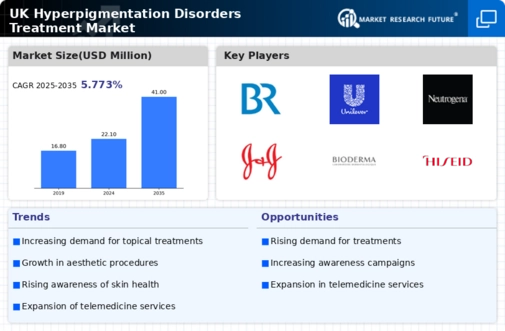Growing Awareness of Skin Health
The increasing awareness of skin health among the UK population is a pivotal driver for the hyperpigmentation disorders-treatment market. As consumers become more informed about skin conditions and their treatments, there is a notable rise in demand for effective solutions. This trend is reflected in the growing number of dermatology clinics and skincare brands focusing on hyperpigmentation. According to recent data, the UK skincare market is projected to reach £3.5 billion by 2026, with a significant portion attributed to treatments addressing hyperpigmentation. This heightened awareness encourages individuals to seek professional advice and invest in products that promise visible results, thereby propelling the market forward.
Rising Incidence of Skin Disorders
The rising incidence of skin disorders, particularly among the UK population, serves as a crucial driver for the hyperpigmentation disorders-treatment market. Factors such as increased sun exposure, pollution, and lifestyle changes contribute to the prevalence of conditions like melasma and post-inflammatory hyperpigmentation. Recent statistics indicate that approximately 30% of adults in the UK experience some form of hyperpigmentation, highlighting a substantial patient base. This growing prevalence necessitates the development and availability of targeted treatments, thereby stimulating market growth. As healthcare providers respond to this demand, the hyperpigmentation disorders-treatment market is likely to witness significant expansion.
Advancements in Dermatological Research
Advancements in dermatological research are significantly influencing the hyperpigmentation disorders-treatment market. Innovations in treatment methodologies, such as laser therapies and topical agents, have emerged from ongoing research efforts. For instance, the introduction of novel compounds that target melanin production has shown promising results in clinical trials. The UK has seen a surge in research funding, with an estimated £200 million allocated to dermatological studies in recent years. This influx of resources is likely to enhance the efficacy of treatments available, thereby attracting more patients seeking solutions for hyperpigmentation disorders. As a result, the market is expected to expand as new, effective treatments become accessible.
Influence of Social Media and Beauty Trends
the influence of social media and evolving beauty trends significantly shapes the hyperpigmentation disorders treatment market. Platforms such as Instagram and TikTok have become powerful tools for beauty influencers to promote skincare products and treatments. This trend has led to an increased focus on achieving flawless skin, driving consumers to seek solutions for hyperpigmentation. The UK beauty industry has reported a 15% increase in sales of products targeting skin imperfections over the past year. As consumers are exposed to various treatment options through social media, the demand for effective hyperpigmentation solutions is likely to rise, further propelling market growth.
Regulatory Support for Innovative Treatments
Regulatory support for innovative treatments is emerging as a key driver in the hyperpigmentation disorders-treatment market. The UK government has implemented policies aimed at facilitating the approval of new dermatological therapies, thereby encouraging pharmaceutical companies to invest in research and development. This supportive regulatory environment is crucial for bringing novel treatments to market more efficiently. Recent initiatives have streamlined the approval process for dermatological products, potentially reducing the time to market by up to 30%. As a result, the hyperpigmentation disorders-treatment market is expected to benefit from a wider array of treatment options, catering to the diverse needs of patients.





















Leave a Comment